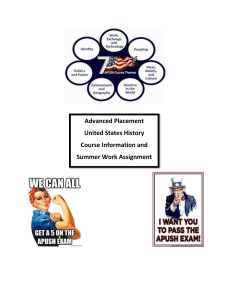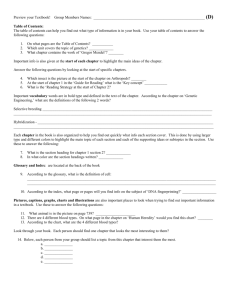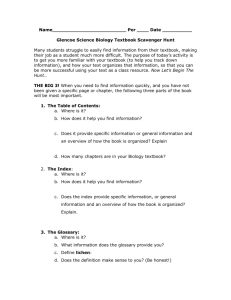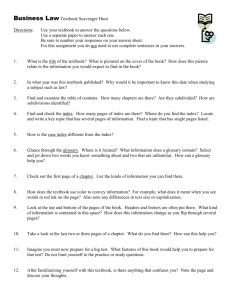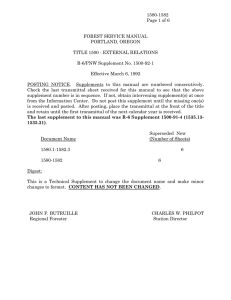105-Exam-1-SG-Ch-1†3-NEW
advertisement
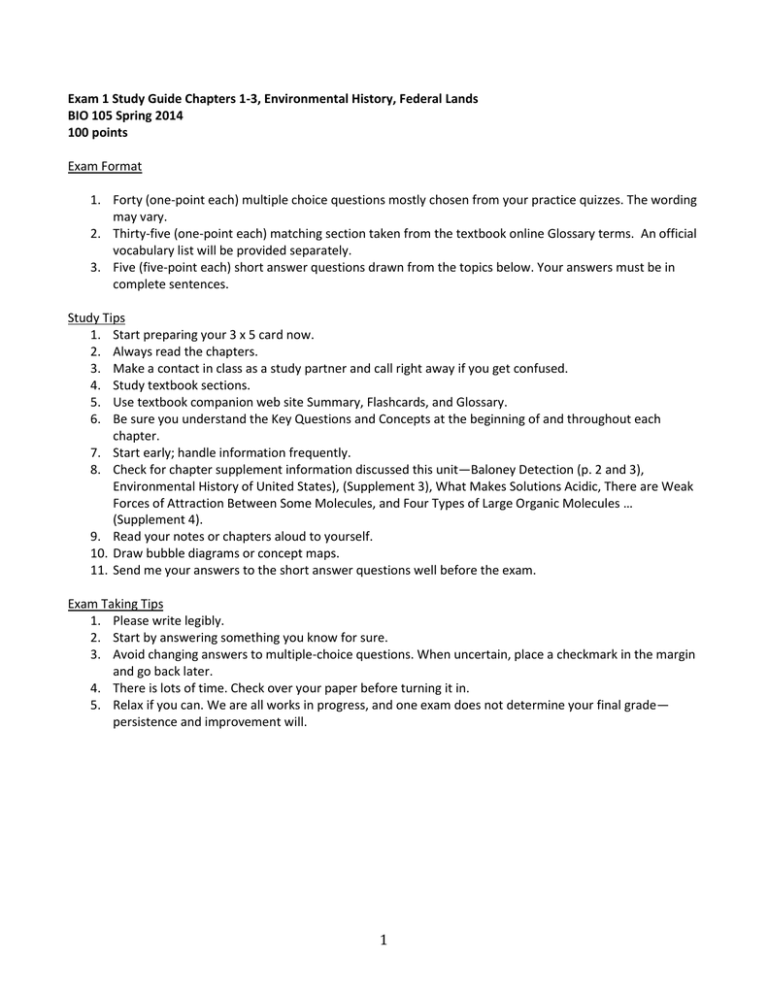
Exam 1 Study Guide Chapters 1-3, Environmental History, Federal Lands BIO 105 Spring 2014 100 points Exam Format 1. Forty (one-point each) multiple choice questions mostly chosen from your practice quizzes. The wording may vary. 2. Thirty-five (one-point each) matching section taken from the textbook online Glossary terms. An official vocabulary list will be provided separately. 3. Five (five-point each) short answer questions drawn from the topics below. Your answers must be in complete sentences. Study Tips 1. Start preparing your 3 x 5 card now. 2. Always read the chapters. 3. Make a contact in class as a study partner and call right away if you get confused. 4. Study textbook sections. 5. Use textbook companion web site Summary, Flashcards, and Glossary. 6. Be sure you understand the Key Questions and Concepts at the beginning of and throughout each chapter. 7. Start early; handle information frequently. 8. Check for chapter supplement information discussed this unit—Baloney Detection (p. 2 and 3), Environmental History of United States), (Supplement 3), What Makes Solutions Acidic, There are Weak Forces of Attraction Between Some Molecules, and Four Types of Large Organic Molecules … (Supplement 4). 9. Read your notes or chapters aloud to yourself. 10. Draw bubble diagrams or concept maps. 11. Send me your answers to the short answer questions well before the exam. Exam Taking Tips 1. Please write legibly. 2. Start by answering something you know for sure. 3. Avoid changing answers to multiple-choice questions. When uncertain, place a checkmark in the margin and go back later. 4. There is lots of time. Check over your paper before turning it in. 5. Relax if you can. We are all works in progress, and one exam does not determine your final grade— persistence and improvement will. 1 Four Square Grading Components For Exam 1 Accurate spelling Neat, legible handwriting Complete, proper sentences In-person students: Materials off counter while testing Online students: Clear communication about proctoring site CHAPTER 1 POTENTIAL SHORT ANSWER QUESTIONS 1. Name and briefly describe the components of the real price of goods? 2. The authors suggest humans need to mimic the three strategies nature has followed toward sustainability. Name and describe these principles. 3. Name and describe the major cultural changes (revolutions) that have occurred in human history and a characteristic of each. 4. Describe the four root causes of environmental problems. 5. Discuss the effects of poverty and affluence on environmental degradation. In other words, how and why does each negatively affect the environment? 6. What is exponential growth? What shape is its curve on a graph? What is the shape of the curve on today’s population graph? CHAPTER 2 POTENTIAL SHORT ANSWER QUESTIONS 1. 2. 3. 4. 5. 6. What is science? State five limitations of science. Describe what Garrett Hardin meant by the Tragedy of the Commons and give an example. What is scientific probability? Give a mathematical example in the form of a fraction. What is a system and what are its components? Give an example of an ecological system. Give an example of a negative feedback loop and describe how it operates. State the second law of thermodynamics. CHAPTER 3 POTENTIAL SHORT ANSWER QUESTIONS 1. Name two components of the natural nitrogen cycle. Name two ways humans interfere with it. 2. Name two components of the natural carbon cycle. Name two ways humans interfere with it. 3. Explain the relationship between the second law of thermodynamics and the flow of energy through food chain. More on next page 4. What is soil? How is it formed? What organisms play a role in its formation? 2 5. Describe the four major components of what your textbook refers to as “earth’s life support system.” Include locations and two significant characteristics of each. 6. Explain the natural greenhouse effect. ENVIRONMENTAL HISTORY OF US POTENTIAL SHORT ANSWER QUESTIONS 1. Name three environmental milestones in each of these eras. a. Early Conservation Era 1832-1870 b. 1870-1930 c. 1930-19601960s d. 1970s e. 1980s f. 1990-2010 FEDERAL LANDS USE POTENTIAL SHORT ANSWER QUESTIONS 1. Federal lands are managed through what four agencies? 2. Explain one unique characteristic for each of these agencies that distinguishes it from the others. 3

